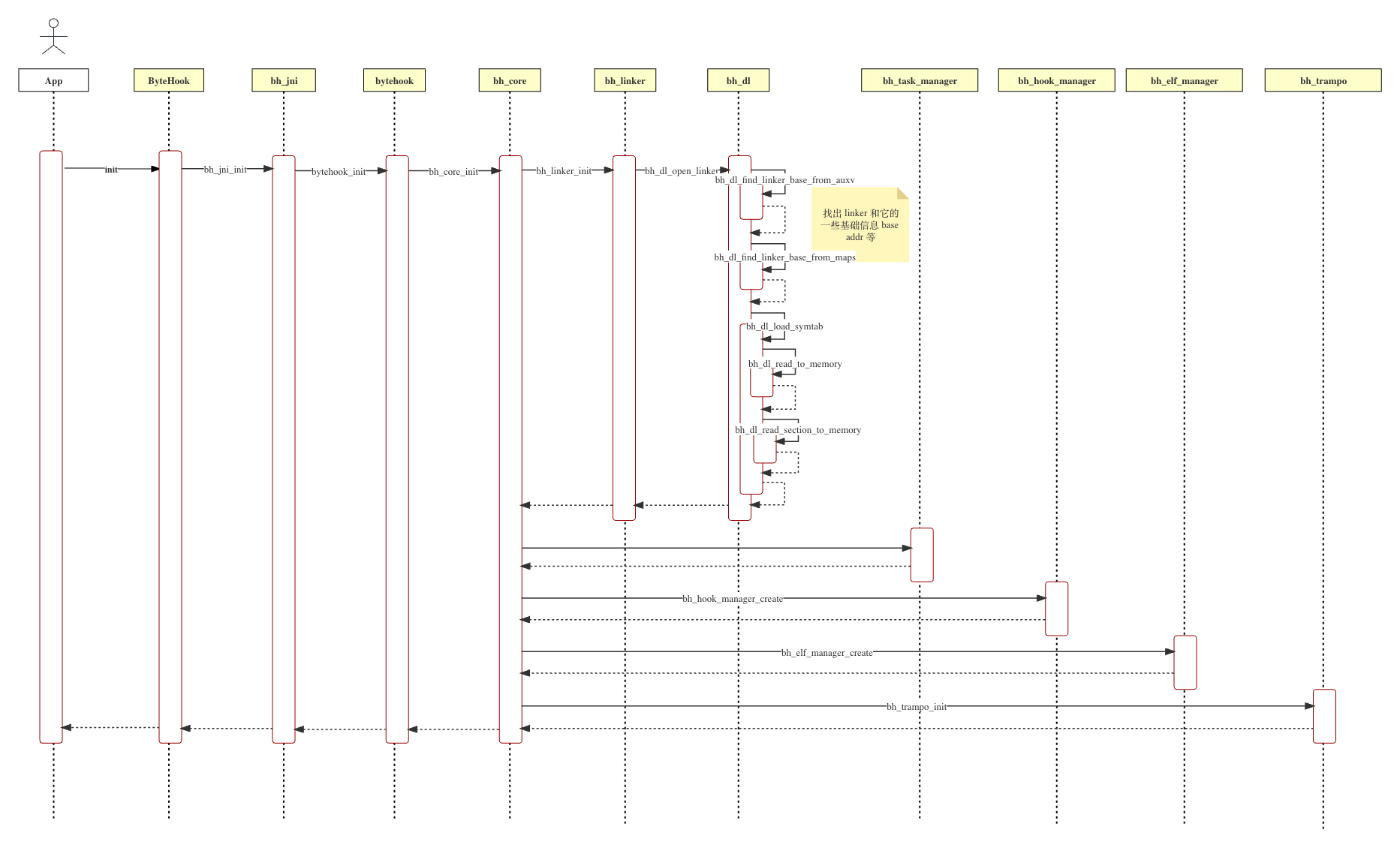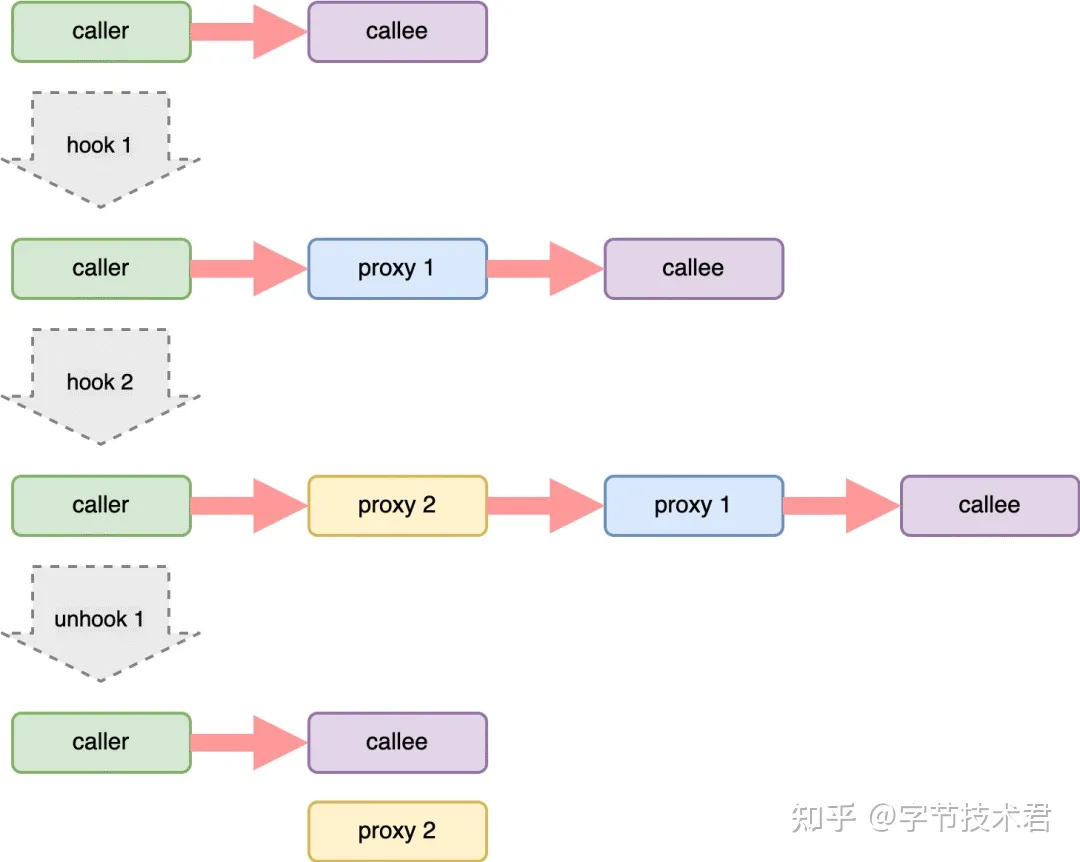一、本文目的 前文中写了一个 native hook 的简单例子。 本文将分析下字节开源的 bhook 是怎么实现的。
字节关于 bhook 的介绍在这里,上面提到:
- 可以随时 hook 和 unhook 单个、部分、全部的调用者 ELF。
- 当新的 ELF 被加载到内存后,它应该自动的被执行所有预定的 hook 操作。
- 多个使用方如果 hook 了同一个调用点,它们应该可以彼此独立的执行 unhook,相互不干扰。
- 能自动避免由于 hook 引起的意外的“递归调用”和“环形调用”。
二、源码分析
2.1 初始化
 上图是 bhook 初始化流程,核心逻辑在 bh_dl_open_linker 这个方法中。其会找到 android linker 的 base addr,以及将 linker 的符号表加载到内存中供后序使用。
上图是 bhook 初始化流程,核心逻辑在 bh_dl_open_linker 这个方法中。其会找到 android linker 的 base addr,以及将 linker 的符号表加载到内存中供后序使用。
初始化是还创建了 task manager、 hook manager 和 elf manager 等用于以后对 task 和 elf 的管理。
2.2 Hook 单个、部分还是全部调用者 ELF
2.2.1 Hook api
bhook 提供了 api ,使用者可以选择 hook 单个、部分或全部。
bytehook_stub_t bytehook_hook_single(const char *caller_path_name, const char *callee_path_name,
const char *sym_name, void *new_func, bytehook_hooked_t hooked,
void *hooked_arg) {
const void *caller_addr = __builtin_return_address(0);
return bh_core_hook_single(caller_path_name, callee_path_name, sym_name, new_func, hooked, hooked_arg,
(uintptr_t)caller_addr);
}
bytehook_stub_t bytehook_hook_partial(bytehook_caller_allow_filter_t caller_allow_filter,
void *caller_allow_filter_arg, const char *callee_path_name,
const char *sym_name, void *new_func, bytehook_hooked_t hooked,
void *hooked_arg) {
const void *caller_addr = __builtin_return_address(0);
return bh_core_hook_partial(caller_allow_filter, caller_allow_filter_arg, callee_path_name, sym_name,
new_func, hooked, hooked_arg, (uintptr_t)caller_addr);
}
bytehook_stub_t bytehook_hook_all(const char *callee_path_name, const char *sym_name, void *new_func,
bytehook_hooked_t hooked, void *hooked_arg) {
const void *caller_addr = __builtin_return_address(0);
return bh_core_hook_all(callee_path_name, sym_name, new_func, hooked, hooked_arg, (uintptr_t)caller_addr);
}
2.2.2 Hook task
对于每个 hook “行为”,bhook 为其创建对应的 bh_task,便于后续管理。 bh_task 中定义了 bh_task_type_t 用于标识 hook 类型,bytehook_caller_allow_filter_t,caller_path_name 用于后续 hook 时找到对应的 elf 。
typedef struct bh_task {
uint32_t id; // unique id
bh_task_type_t type;
bh_task_status_t status;
// caller
char *caller_path_name; // for single
bytehook_caller_allow_filter_t caller_allow_filter; // for partial
void *caller_allow_filter_arg; // for partial
// callee
char *callee_path_name;
void *callee_addr;
// symbol
char *sym_name;
// new function address
void *new_func;
// callback
bytehook_hooked_t hooked;
void *hooked_arg;
int hook_status_code; // for single type
void *manual_orig_func; // for manual mode
TAILQ_ENTRY(bh_task, ) link;
} bh_task_t;
2.2.3 hook
Hook 时会根据 bh_task_t 类型做不同处理。
bh_task_handle
static void bh_task_handle(bh_task_t *self) {
switch (self->type) {
case BH_TASK_TYPE_SINGLE: {
bh_elf_t *caller_elf = bh_elf_manager_find_elf(bh_core_global()->elf_mgr, self->caller_path_name);
if (NULL != caller_elf) bh_task_hook_or_unhook(self, caller_elf);
break;
}
case BH_TASK_TYPE_ALL:
case BH_TASK_TYPE_PARTIAL:
bh_elf_manager_iterate(bh_core_global()->elf_mgr, bh_task_elf_iterate_cb, (void *)self);
break;
}
}
Single 类型的 hook 直接调用 bh_task_hook_or_unhook。 其他类型的先遍历,对于每个 elf 执行 bh_task_hook_or_unhook。
bh_elf_manager_iterate
void bh_elf_manager_iterate(bh_elf_manager_t *self, bh_elf_manager_iterate_cb_t cb, void *cb_arg) {
if (0 == self->elfs_cnt) return;
// get a copy of ELFs (only the pointers)
bh_elf_t **copy_elfs = NULL;
size_t copy_elfs_cnt = 0;
pthread_rwlock_rdlock(&self->elfs_lock);
if (self->elfs_cnt > 0) {
if (NULL != (copy_elfs = malloc(sizeof(bh_elf_t *) * self->elfs_cnt))) {
copy_elfs_cnt = self->elfs_cnt;
size_t i = 0;
bh_elf_t *elf;
RB_FOREACH(elf, bh_elf_tree, &self->elfs) {
copy_elfs[i++] = elf;
}
}
}
pthread_rwlock_unlock(&self->elfs_lock);
// do callback copy ELFs (no need to lock)
if (NULL != copy_elfs) {
bool cb_next = true;
for (size_t i = 0; i < copy_elfs_cnt; i++) {
if (cb_next) cb_next = cb(copy_elfs[i], cb_arg);
}
free(copy_elfs);
}
}
static bool bh_task_elf_iterate_cb(bh_elf_t *elf, void *arg) {
return bh_task_hook_or_unhook((bh_task_t *)arg, elf);
}
bh_task_hook_or_unhook
static bool bh_task_hook_or_unhook(bh_task_t *self, bh_elf_t *elf) {
void (*hook_or_unhook)(bh_hook_manager_t *, bh_task_t *, bh_elf_t *) =
(BH_TASK_STATUS_UNHOOKING == self->status ? bh_hook_manager_unhook : bh_hook_manager_hook);
switch (self->type) {
case BH_TASK_TYPE_SINGLE:
if (bh_elf_is_match(elf, self->caller_path_name)) {
hook_or_unhook(bh_core_global()->hook_mgr, self, elf);
if (BH_TASK_STATUS_UNHOOKING != self->status) self->status = BH_TASK_STATUS_FINISHED;
return false; // already found the ELF for single task, no need to continue
}
return true; // continue
case BH_TASK_TYPE_PARTIAL:
if (self->caller_allow_filter(elf->pathname, self->caller_allow_filter_arg))
hook_or_unhook(bh_core_global()->hook_mgr, self, elf);
return true; // continue
case BH_TASK_TYPE_ALL:
hook_or_unhook(bh_core_global()->hook_mgr, self, elf);
return true; // continue
}
}
bh_task_hook_or_unhook 如果是部分 hook 会根据 caller_allow_filter 判断是否需要 hook。
2.2.4 小结
- bh_task 中定义了 hook 类型以及单个 hook 和部分 hook 的条件。
- 如果是单个 hook 直接找到对应的 elf 执行 hook。
- 如果是部分 hook 会遍历所有已加载的 elf ,如果复合 hook 条件,则 hook。
2.3 新 ELF 自动 hook
 dl_open 后 bhook 的后序方法调用如图。
bhook hook 了 dl_open 方法,linker dl_open 之后会回到 bhook。
bhook 之后会对新加载的 elf 执行 hook。同样 dl_close 之后同样会执行相应的 unhook。
整个过程比较清晰,就不贴具体代码了。
dl_open 后 bhook 的后序方法调用如图。
bhook hook 了 dl_open 方法,linker dl_open 之后会回到 bhook。
bhook 之后会对新加载的 elf 执行 hook。同样 dl_close 之后同样会执行相应的 unhook。
整个过程比较清晰,就不贴具体代码了。
2.4 避免环形调用和递归调用
根据字节介绍他们使用了 trampoline 来避免“递归调用” 和“环形调用”。

2.4.1 trampoline 的创建
hook create:
static bh_hook_t *bh_hook_manager_create_hook(bh_hook_manager_t *self, void *got_addr, void *orig_func,
void **trampo) {
// create hook chain
bh_hook_t *hook = bh_hook_create(got_addr, orig_func);
if (NULL == hook) return NULL;
// create trampoline for the hook chain
*trampo = bh_trampo_create(hook);
if (NULL == *trampo) {
bh_hook_destroy(&hook);
return NULL;
}
// save the hook chain
RB_INSERT(bh_hook_tree, &self->hooks, hook);
BH_LOG_INFO("hook chain: created for GOT %" PRIxPTR ", orig func %" PRIxPTR, (uintptr_t)got_addr,
(uintptr_t)orig_func);
return hook;
}
创建 b_hook 的时候会为当前 b_hook 创建一个 trampo。
bh_trampo_create:
void *bh_trampo_create(bh_hook_t *hook) {
size_t code_size = (uintptr_t)(&bh_trampo_data) - (uintptr_t)(bh_trampo_template_pointer());
size_t data_size = sizeof(void *) + sizeof(void *);
// create trampoline
void *trampo = bh_trampo_allocate(code_size + data_size);
if (NULL == trampo) return NULL;
// fill in code
BYTESIG_TRY(SIGSEGV, SIGBUS) {
memcpy(trampo, bh_trampo_template_pointer(), code_size);
}
BYTESIG_CATCH() {
return NULL;
}
BYTESIG_EXIT
// file in data
void **data = (void **)((uintptr_t)trampo + code_size);
*data++ = (void *)bh_trampo_push_stack;
*data = (void *)hook;
// clear CPU cache
__builtin___clear_cache((char *)trampo, (char *)trampo + code_size + data_size);
BH_LOG_INFO("trampo: created for GOT %" PRIxPTR " at %" PRIxPTR ", size %zu + %zu = %zu",
(uintptr_t)hook->got_addr, (uintptr_t)trampo, code_size, data_size, code_size + data_size);
#if defined(__arm__) && defined(__thumb__)
trampo = (void *)((uintptr_t)trampo + 1);
#endif
return trampo;
}
上述方法中的 bh_trampo_template_pointer 如下(arm64):
__attribute__((naked)) void bh_trampo_template() {
__asm__(
// Save caller-saved registers
"sub sp, sp, #0xd0 \n"
"stp q0, q1, [sp, #0xb0] \n"
"stp q2, q3, [sp, #0x90] \n"
"stp q4, q5, [sp, #0x70] \n"
"stp q6, q7, [sp, #0x50] \n"
"stp x0, x1, [sp, #0x40] \n"
"stp x2, x3, [sp, #0x30] \n"
"stp x4, x5, [sp, #0x20] \n"
"stp x6, x7, [sp, #0x10] \n"
"stp x8, lr, [sp] \n"
// Call bh_trampo_push_stack()
"ldr x0, .L_hook_ptr \n"
"mov x1, lr \n"
"ldr x16, .L_push_stack \n"
"blr x16 \n"
// Save the hook function's address to IP register
"mov x16, x0 \n"
// Restore caller-saved registers
"ldp x8, lr, [sp] \n"
"ldp x6, x7, [sp, #0x10] \n"
"ldp x4, x5, [sp, #0x20] \n"
"ldp x2, x3, [sp, #0x30] \n"
"ldp x0, x1, [sp, #0x40] \n"
"ldp q6, q7, [sp, #0x50] \n"
"ldp q4, q5, [sp, #0x70] \n"
"ldp q2, q3, [sp, #0x90] \n"
"ldp q0, q1, [sp, #0xb0] \n"
"add sp, sp, #0xd0 \n"
// Call hook function
"br x16 \n"
"bh_trampo_data:"
".global bh_trampo_data;"
".L_push_stack:"
".quad 0;"
".L_hook_ptr:"
".quad 0;");
}
trampo 创建过程中涉及到一段汇编,比较复杂,整理后逻辑如下:
- 申请一块内存,大小是 code_size + data_size,code_size 大小是 bh_trampo_data 减去 bh_trampo_template_pointer。
- bh_trampo_data 是在汇编模版中定义,bh_trampo_template_pointer 指向这段汇编的起始地址,因此 code_size 就是 bh_trampo_data 之前的这段代码所需要的内存空间。
- data_size 大小是两个 sizeof(void *),也就是两个指针。一个只想 bh_trampo_push_stack 这个方法,一个指向当前 hook。
- bh_hook 中有一个链表,链表中记录着当前 callee 方法的所有 proxy 方法。
2.4.2 trampo 的使用
根据字节官方图 hook 之后 caller 调用 trampoline ,trampoline 之后是一系列 proxy 方法,最后才是 callee。 trampoline 指向一段汇编,这段汇编逻辑如下:
- 保存当前寄存器中的数据,参数、返回地址等。
- 调用 bh_trampo_push_stack 。
- bh_trampo_push_stack 会记录已经调用过的 proxy 方法,并判断有没有环形调用。
- 如果没有环形调用,返回下一个 proxy 方法。
- 如果有环形调用,直接返回原始方法。
- 恢复 caller 所传的参数等数据,并调用 bh_trampo_push_stack 所返回的方法。
2.4.3 trampo 替换原函数
创建了 trampo 之后在 hook 时使用 trampo 替换 origin func。
static int bh_hook_manager_hook_single_got(bh_hook_manager_t *self, bh_elf_t *caller_elf, bh_task_t *task,
void *got_addr, void **orig_func_ret) {
...
// 1. add new-func to the hook chain
void *trampo = NULL;
void *orig_func_real = NULL;
r = bh_hook_manager_add_func(self, caller_elf, got_addr, orig_func, task, &trampo, &orig_func_real);
// 2. replace with the trampoline address if we haven't done it yet
if (0 == r && NULL != trampo) {
r = bh_hook_manager_replace_got_value(caller_elf, task, got_addr, orig_func, trampo);
...
return r;
}
2.4.4 小结
- trampoline 其实是一段汇编,这段汇编中包含两部分,代码和数据。
- 代码部分用于保存和恢复原始方法原始方法的参数,返回地址等。
- 两个数据指针一个指向 bh_trampo_push_stack 一个指向 b_hook。
- b_hook 中有一个链表,其中保存着当前原始方法的所有 proxy 方法。
- bh_trampo_push_stack 会判断是否有环形调用以及下一个需要调用的方法。